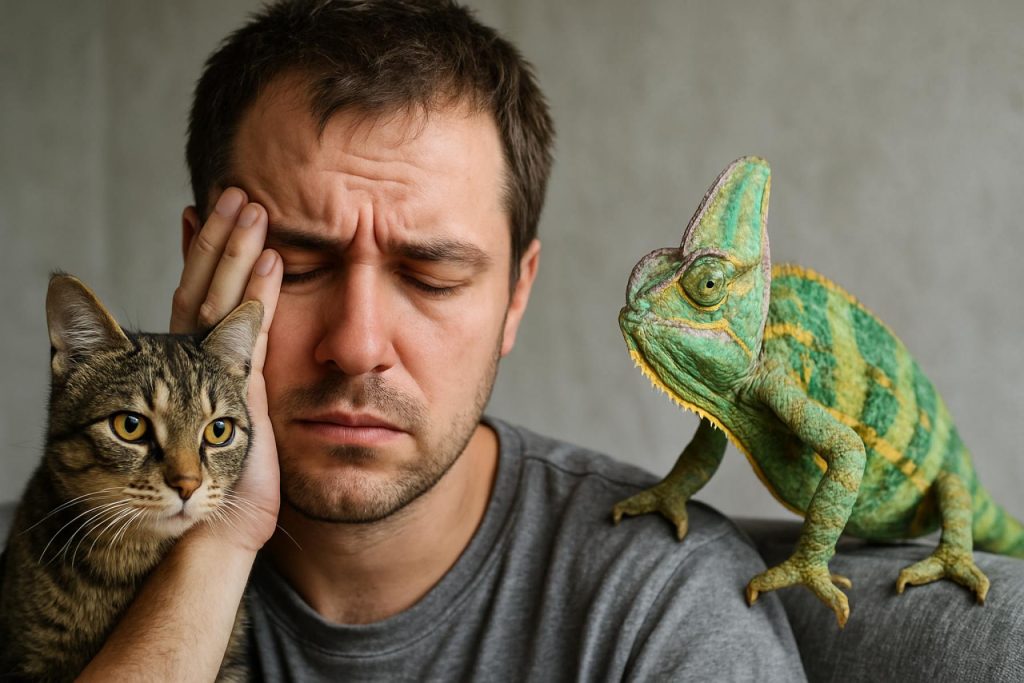
Unmasking Toxoplasmosis: What Every Exotic Pet Owner Needs to Know About This Silent Zoonotic Risk. Discover How This Parasite Could Impact Your Health and the Future of Exotic Pet Care. (2025)
- Introduction: Toxoplasmosis and the Rise of Exotic Pets
- Understanding Toxoplasma gondii: The Parasite Behind the Disease
- Transmission Pathways: How Exotic Pets Contribute to Human Infection
- High-Risk Species: Which Exotic Pets Pose the Greatest Threat?
- Clinical Manifestations: Symptoms in Humans and Animals
- Diagnostic Advances: Current and Emerging Detection Technologies
- Prevention and Control: Best Practices for Exotic Pet Owners
- Regulatory Landscape: Guidelines from Health Authorities (cdc.gov, who.int)
- Market and Public Interest Trends: Exotic Pet Ownership and Toxoplasmosis Awareness (Estimated 15% Growth in Public Attention by 2027)
- Future Outlook: Innovations, Education, and the Evolving Risk Landscape
- Sources & References
Introduction: Toxoplasmosis and the Rise of Exotic Pets
Toxoplasmosis, a parasitic disease caused by Toxoplasma gondii, has long been recognized as a significant zoonotic threat, particularly in relation to domestic cats, the definitive hosts of the parasite. However, the landscape of pet ownership is rapidly evolving. In 2025, the global trend toward keeping exotic animals—ranging from reptiles and birds to small mammals and even wild felids—as household companions is accelerating. This shift brings new dimensions to the epidemiology and public health implications of toxoplasmosis.
Exotic pets, while often perceived as less likely to transmit traditional zoonoses, can play a role in the life cycle of T. gondii. Many species, including rodents, birds, and certain marsupials, can serve as intermediate hosts, harboring tissue cysts that may infect other animals or humans through direct or indirect contact. The increased movement of exotic animals across borders, both legally and illegally, has heightened concerns about the introduction and spread of toxoplasmosis in non-endemic regions. Regulatory bodies such as the World Organisation for Animal Health (WOAH) and the Centers for Disease Control and Prevention (CDC) have issued advisories highlighting the risks associated with exotic pet trade and ownership, emphasizing the need for robust surveillance and public education.
Recent data suggest that the prevalence of toxoplasmosis in exotic pet populations is not negligible. For example, serological surveys in captive exotic mammals and birds have revealed varying rates of exposure, with some species demonstrating significant susceptibility. The World Health Organization (WHO) continues to monitor zoonotic diseases, including toxoplasmosis, as part of its One Health approach, recognizing the interconnectedness of human, animal, and environmental health. In 2025, the WHO and allied organizations are prioritizing research into emerging zoonoses linked to the exotic pet trade, aiming to better understand transmission dynamics and risk factors.
Looking ahead, the outlook for toxoplasmosis in the context of exotic pet ownership is shaped by several factors: the ongoing popularity of unconventional pets, gaps in owner awareness, and the challenges of enforcing biosecurity measures. As the exotic pet market expands, public health authorities anticipate a need for updated guidelines, targeted outreach, and enhanced diagnostic capabilities to mitigate the risks posed by toxoplasmosis and other zoonotic infections. The coming years will likely see increased collaboration between veterinary, medical, and regulatory sectors to address these evolving challenges.
Understanding Toxoplasma gondii: The Parasite Behind the Disease
Toxoplasma gondii is a protozoan parasite recognized as the causative agent of toxoplasmosis, a zoonotic disease of global significance. The parasite’s complex life cycle involves both definitive hosts—primarily felids (domestic and wild cats)—and a wide range of intermediate hosts, including birds, rodents, and numerous exotic species commonly kept as pets. In 2025, the increasing popularity of exotic pet ownership has heightened concerns regarding the transmission dynamics and public health implications of T. gondii.
T. gondii is unique in that it can infect virtually all warm-blooded animals, but only felids shed the environmentally resistant oocysts in their feces. These oocysts can persist in soil, water, and on surfaces for months, posing a risk to other animals and humans who may inadvertently ingest them. Exotic pets such as reptiles, birds, and small mammals can become intermediate hosts through contaminated food, water, or substrate, and may serve as reservoirs for the parasite within household environments. The Centers for Disease Control and Prevention (CDC) has emphasized that while direct transmission from exotic pets to humans is less common than from cats, the risk is not negligible, especially in immunocompromised individuals and pregnant women (Centers for Disease Control and Prevention).
Recent molecular studies have revealed that T. gondii strains circulating among exotic pet populations can exhibit genetic diversity, potentially influencing pathogenicity and transmission efficiency. Surveillance data from veterinary and public health authorities indicate sporadic outbreaks linked to exotic pet collections, particularly in settings where hygiene and biosecurity measures are insufficient. The World Organisation for Animal Health (WOAH), an intergovernmental body responsible for improving animal health worldwide, has called for enhanced monitoring of T. gondii in non-traditional pets, citing the parasite’s adaptability and the growing movement of exotic species across borders (World Organisation for Animal Health).
Looking ahead, the outlook for toxoplasmosis in the context of exotic pet ownership is shaped by several factors: the continued expansion of the exotic pet trade, evolving husbandry practices, and advances in diagnostic technologies. Efforts are underway to develop more sensitive detection methods for T. gondii in both animals and environmental samples, which may improve early identification and control. Public health agencies and veterinary organizations are expected to intensify educational campaigns targeting exotic pet owners, emphasizing the importance of regular veterinary screening, proper sanitation, and responsible sourcing of animals. As the landscape of pet ownership evolves, so too will strategies to mitigate the risks associated with T. gondii, with a focus on safeguarding both animal and human health.
Transmission Pathways: How Exotic Pets Contribute to Human Infection
Toxoplasmosis, caused by the protozoan parasite Toxoplasma gondii, remains a significant zoonotic concern, particularly in the context of exotic pet ownership. As of 2025, the global trade and keeping of exotic animals—ranging from reptiles and birds to small mammals—has expanded, increasing the complexity of transmission pathways for this parasite. While domestic cats are the definitive hosts, exotic pets can serve as intermediate hosts or mechanical vectors, contributing to human infection through several mechanisms.
One primary transmission route is the ingestion of oocysts shed in the feces of infected felids, including wild cat species sometimes kept as exotic pets. These oocysts can contaminate enclosures, bedding, or water sources, posing a risk to owners during cleaning or handling. Additionally, exotic mammals such as rodents, marsupials, and primates may harbor tissue cysts if they consume contaminated food or water, and humans can become infected through direct contact with these animals or their excretions. The risk is heightened in settings where exotic pets are housed in close proximity to each other or to humans, such as private collections or petting zoos.
Recent surveillance data and risk assessments by organizations such as the Centers for Disease Control and Prevention and the World Health Organization highlight the potential for emerging zoonotic diseases, including toxoplasmosis, in the context of the exotic pet trade. The World Organisation for Animal Health (WOAH, formerly OIE) has also underscored the importance of monitoring and regulating the movement of exotic species to prevent the spread of infectious agents. In 2025, these organizations continue to emphasize the need for improved biosecurity, routine screening of imported animals, and public education on safe handling practices.
Another notable pathway involves the feeding of raw or undercooked meat to carnivorous exotic pets, which can perpetuate the life cycle of T. gondii within captive environments. This practice, still common among some exotic pet owners, increases the risk of both animal and human infection. Furthermore, environmental persistence of oocysts—capable of surviving in soil or water for months—means that indirect transmission remains a concern, especially in households with multiple animal species.
Looking ahead, the outlook for toxoplasmosis transmission in exotic pet ownership will depend on the effectiveness of regulatory measures, public awareness campaigns, and advances in diagnostic screening. As the exotic pet industry continues to grow, coordinated efforts by veterinary and public health authorities will be crucial to mitigate the risks associated with this complex zoonosis.
High-Risk Species: Which Exotic Pets Pose the Greatest Threat?
Toxoplasmosis, caused by the protozoan parasite Toxoplasma gondii, remains a significant zoonotic concern in the context of exotic pet ownership in 2025. While domestic cats are the definitive hosts, a growing body of research highlights that several exotic species can also harbor and transmit the parasite, posing risks to both owners and other animals. The increasing popularity of exotic pets—ranging from small mammals to reptiles and birds—necessitates a closer examination of which species present the highest risk for toxoplasmosis transmission.
Among exotic pets, felids such as servals, caracals, and other wild cat species are of particular concern. Like domestic cats, these animals can shed oocysts in their feces after ingesting infected prey or raw meat, contaminating the environment and increasing the risk of human exposure. The Centers for Disease Control and Prevention (CDC) emphasizes that all members of the Felidae family are potential definitive hosts, capable of completing the parasite’s life cycle and shedding infectious oocysts.
Other mammals, including certain marsupials (e.g., sugar gliders) and rodents, can become infected with T. gondii but do not shed oocysts. Instead, they act as intermediate hosts, harboring tissue cysts that can infect other animals or humans if consumed. While the risk of direct transmission from these species is lower, improper handling or feeding practices—such as offering raw or undercooked meat—can facilitate indirect transmission.
Reptiles and birds, commonly kept as exotic pets, are generally considered low-risk for toxoplasmosis transmission. These species are not natural hosts for T. gondii and do not contribute to environmental contamination with oocysts. However, they can act as mechanical vectors if their enclosures become contaminated with oocysts from infected felids.
Recent surveillance data and risk assessments from organizations such as the World Organisation for Animal Health (WOAH, formerly OIE) and the World Health Organization (WHO) continue to highlight the importance of monitoring exotic felids in private collections and zoological settings. In 2025, regulatory bodies are expected to strengthen guidelines for the import, housing, and care of high-risk species, with a focus on minimizing zoonotic transmission.
Looking ahead, the outlook for toxoplasmosis risk in exotic pet ownership will depend on improved owner education, stricter biosecurity measures, and ongoing research into the prevalence of T. gondii in non-domestic species. As the exotic pet trade evolves, collaboration between veterinary authorities, public health agencies, and international organizations will be crucial to mitigate the risks associated with high-risk species.
Clinical Manifestations: Symptoms in Humans and Animals
Toxoplasmosis, caused by the protozoan parasite Toxoplasma gondii, remains a significant zoonotic concern in the context of exotic pet ownership as of 2025. The clinical manifestations of toxoplasmosis vary widely, influenced by host species, immune status, and the route of infection. In humans, the majority of infections are asymptomatic, but immunocompromised individuals and pregnant women are at heightened risk for severe disease. Among exotic pets, particularly those with close human contact, the spectrum of symptoms is similarly diverse and often species-dependent.
In humans, acute toxoplasmosis may present with mild, flu-like symptoms such as fever, lymphadenopathy, and myalgia. However, in immunosuppressed individuals—such as those with HIV/AIDS, organ transplant recipients, or patients undergoing chemotherapy—reactivation of latent infection can lead to severe complications, including encephalitis, pneumonitis, and ocular disease. Congenital toxoplasmosis, resulting from maternal infection during pregnancy, can cause miscarriage, stillbirth, or long-term neurological and ocular sequelae in infants. The Centers for Disease Control and Prevention (CDC) continues to emphasize the risk of toxoplasmosis in these vulnerable populations, especially in the context of increased exotic pet ownership.
Among exotic pets, clinical signs of toxoplasmosis are highly variable. Felids, including exotic species such as servals and caracals, are definitive hosts and often remain asymptomatic while shedding oocysts in their feces. Other exotic mammals—such as sugar gliders, hedgehogs, and certain primates—can develop acute or chronic disease, with symptoms ranging from lethargy, anorexia, and respiratory distress to neurological deficits and sudden death. Birds and reptiles are generally less susceptible, but sporadic cases have been documented, particularly in immunocompromised or stressed individuals. The World Organisation for Animal Health (WOAH, formerly OIE) monitors zoonotic disease trends and has noted sporadic outbreaks of toxoplasmosis in captive exotic animal populations, underscoring the need for vigilance in husbandry and veterinary care.
Looking ahead, the increasing popularity of exotic pets is expected to sustain the relevance of toxoplasmosis as a public health and veterinary concern. Enhanced diagnostic capabilities, including molecular assays and serological testing, are improving detection rates in both humans and animals. However, the asymptomatic nature of many infections complicates surveillance efforts. Ongoing education for exotic pet owners, veterinarians, and healthcare providers—supported by organizations such as the American Veterinary Medical Association (AVMA)—will be critical in mitigating risks and ensuring early recognition of clinical manifestations in both humans and animals through 2025 and beyond.
Diagnostic Advances: Current and Emerging Detection Technologies
The landscape of diagnostic technologies for toxoplasmosis in exotic pet ownership is rapidly evolving as the demand for accurate, rapid, and non-invasive detection methods grows. In 2025, the focus remains on improving early diagnosis to mitigate zoonotic risks and enhance animal welfare, particularly as exotic pets—ranging from reptiles and birds to small mammals—become increasingly popular.
Traditionally, serological assays such as enzyme-linked immunosorbent assay (ELISA) and indirect fluorescent antibody tests (IFAT) have been the mainstay for detecting Toxoplasma gondii antibodies in both animals and humans. These methods, while reliable, often require laboratory infrastructure and may not distinguish between active and past infections. Recent years have seen the refinement of these assays for use in a broader range of exotic species, with species-specific reagents and protocols being developed to address the unique immunological profiles of non-traditional pets.
Molecular diagnostics, particularly polymerase chain reaction (PCR) techniques, have gained prominence due to their high sensitivity and specificity. Real-time PCR assays targeting T. gondii DNA in blood, tissue, or fecal samples are now more widely available and are being adapted for point-of-care use in veterinary clinics. These advances are crucial for exotic pets, where subclinical infections are common and traditional serology may be less informative. The World Organisation for Animal Health (WOAH, formerly OIE) continues to update guidelines for molecular detection, emphasizing the importance of validated protocols for diverse animal hosts.
Emerging technologies in 2025 include isothermal amplification methods such as loop-mediated isothermal amplification (LAMP), which offer rapid results without the need for complex equipment. These assays are being piloted for field use, enabling veterinarians and even trained pet owners to screen for toxoplasmosis in situ. Additionally, biosensor-based platforms and microfluidic devices are under development, aiming to deliver multiplexed, real-time diagnostics that can simultaneously detect multiple pathogens relevant to exotic pets.
Looking ahead, integration of next-generation sequencing (NGS) and metagenomic approaches is anticipated to further enhance detection capabilities, particularly for identifying atypical or emerging strains of T. gondii in exotic species. Collaborative efforts by organizations such as the Centers for Disease Control and Prevention (CDC) and World Health Organization (WHO) are supporting the standardization and global harmonization of diagnostic protocols, with a focus on zoonotic disease surveillance in the context of the expanding exotic pet trade.
In summary, 2025 marks a period of significant progress in toxoplasmosis diagnostics for exotic pets, with ongoing research and technology transfer expected to yield more accessible, accurate, and rapid detection tools in the coming years. These advances are poised to improve both public health outcomes and the management of exotic animal populations.
Prevention and Control: Best Practices for Exotic Pet Owners
Toxoplasmosis, caused by the protozoan parasite Toxoplasma gondii, remains a significant concern for exotic pet owners in 2025, particularly as the popularity of non-traditional pets continues to rise. While domestic cats are the primary definitive hosts, a variety of exotic mammals, birds, and reptiles can act as intermediate hosts, potentially introducing the parasite into household environments. The risk of zoonotic transmission—especially to immunocompromised individuals and pregnant women—necessitates robust prevention and control strategies tailored to the unique challenges of exotic pet ownership.
Current best practices emphasize a multi-faceted approach. First, sourcing animals from reputable breeders or facilities with documented health screening protocols is critical. Many organizations, such as the Centers for Disease Control and Prevention (CDC), recommend that prospective owners inquire about the health status and husbandry practices of breeders to minimize the risk of acquiring infected animals. Quarantine procedures for new arrivals, lasting at least 30 days, are advised to monitor for signs of illness and prevent the introduction of pathogens into established collections.
Hygiene remains a cornerstone of prevention. The American Veterinary Medical Association (AVMA) and the CDC both stress the importance of regular handwashing after handling pets, cleaning enclosures, or coming into contact with animal feces. Litter boxes and enclosures should be cleaned daily, as T. gondii oocysts require 1–5 days to become infectious after being shed. Wearing gloves and using dedicated cleaning tools can further reduce risk. For species known to be potential carriers, such as certain marsupials, rodents, and birds, owners are encouraged to consult with veterinarians experienced in exotic animal medicine for tailored advice.
Dietary management is another key preventive measure. Feeding pets only commercially prepared or thoroughly cooked foods eliminates the risk of introducing T. gondii through raw or undercooked meat. The United States Department of Agriculture (USDA) continues to monitor and regulate the safety of animal feeds, and owners are advised to avoid feeding wild-caught prey or unregulated food sources.
Looking ahead, advances in diagnostic testing and surveillance are expected to improve early detection of toxoplasmosis in exotic species. The CDC and AVMA are collaborating on updated guidelines for veterinarians and pet owners, with a focus on emerging risks associated with the expanding exotic pet trade. Public education campaigns and accessible resources are anticipated to play a growing role in empowering owners to implement effective prevention and control measures, ultimately reducing the incidence of toxoplasmosis in both pets and humans.
Regulatory Landscape: Guidelines from Health Authorities (cdc.gov, who.int)
The regulatory landscape surrounding toxoplasmosis in the context of exotic pet ownership is shaped by evolving guidelines from leading health authorities, notably the Centers for Disease Control and Prevention (CDC) and the World Health Organization (WHO). As of 2025, these organizations continue to update their recommendations in response to the growing popularity of exotic pets and the associated zoonotic risks.
Toxoplasmosis, caused by the protozoan parasite Toxoplasma gondii, is traditionally linked to domestic cats, but increasing evidence highlights the role of exotic felids and other non-traditional pets as potential reservoirs. The CDC, a principal U.S. public health agency, has issued advisories emphasizing the importance of hygiene and safe handling practices for all pet owners, with special attention to those keeping exotic species. Their guidelines stress the need for regular veterinary screening of exotic pets, particularly felids, and recommend that immunocompromised individuals, pregnant women, and young children avoid direct contact with animal feces or litter materials that may harbor oocysts.
The WHO, as the global authority on public health, has reinforced these recommendations in its zoonoses prevention frameworks. In recent years, the WHO has expanded its focus to include the risks posed by the international trade and ownership of exotic animals, recognizing that such practices can facilitate the spread of toxoplasmosis across borders. The organization advocates for harmonized surveillance systems and the implementation of One Health approaches, integrating human, animal, and environmental health strategies to mitigate zoonotic disease transmission.
Both the CDC and WHO have called for enhanced public education campaigns in 2025 and beyond, targeting exotic pet owners and the broader public. These campaigns aim to increase awareness of toxoplasmosis transmission routes, the importance of routine veterinary care, and the necessity of proper sanitation. Additionally, there is a push for stricter importation and quarantine regulations for exotic animals, with the goal of reducing the introduction of T. gondii into new environments.
Looking ahead, the regulatory outlook suggests a trend toward more comprehensive and internationally coordinated guidelines. Health authorities are expected to continue refining their recommendations as new data emerge, particularly regarding the role of less-studied exotic species in the epidemiology of toxoplasmosis. Ongoing collaboration between national agencies like the CDC and international bodies such as the WHO will be critical in shaping effective policies to protect both public health and animal welfare in the context of exotic pet ownership.
Market and Public Interest Trends: Exotic Pet Ownership and Toxoplasmosis Awareness (Estimated 15% Growth in Public Attention by 2027)
The intersection of exotic pet ownership and toxoplasmosis awareness is experiencing notable shifts in 2025, with projections indicating an estimated 15% growth in public attention to the issue by 2027. This trend is driven by increased pet ownership diversity, evolving public health guidance, and heightened media coverage of zoonotic disease risks.
Exotic pets—defined as non-traditional companion animals such as reptiles, birds, and small mammals—have seen a steady rise in popularity, particularly among urban and younger demographics. According to data from the Centers for Disease Control and Prevention (CDC), the U.S. alone has witnessed a significant uptick in households owning exotic pets over the past decade, a trend expected to continue through 2027. This diversification in pet ownership has brought renewed scrutiny to zoonotic diseases, with toxoplasmosis emerging as a focal point due to its potential transmission from certain exotic species, especially those that may serve as intermediate hosts or carry contaminated substrates.
Toxoplasmosis, caused by the protozoan parasite Toxoplasma gondii, is traditionally associated with domestic cats, the definitive hosts. However, recent research and surveillance by organizations such as the World Health Organization (WHO) and the World Organisation for Animal Health (WOAH, formerly OIE) have highlighted the parasite’s presence in a broader range of exotic animals, including some rodents, marsupials, and birds. This has prompted updated advisories and educational campaigns targeting exotic pet owners, veterinarians, and breeders.
Public interest in toxoplasmosis as it relates to exotic pets is further amplified by social media discourse and advocacy from animal welfare and public health organizations. The CDC and WHO have both expanded their online resources and outreach efforts, emphasizing the importance of proper hygiene, regular veterinary screening, and responsible sourcing of exotic pets to mitigate infection risks. These initiatives are expected to contribute to the projected 15% increase in public attention by 2027, as measured by online search trends, engagement with official guidance, and participation in educational programs.
- Increased reporting of toxoplasmosis cases linked to exotic pets is anticipated, driven by improved diagnostic capabilities and surveillance systems.
- Veterinary associations are updating best practice guidelines for exotic pet care, with a focus on zoonotic disease prevention.
- Regulatory bodies may introduce stricter import and trade controls for species identified as higher risk for T. gondii transmission.
Looking ahead, the convergence of rising exotic pet ownership and growing toxoplasmosis awareness is likely to shape both consumer behavior and regulatory frameworks, with ongoing monitoring and public education remaining central to risk mitigation strategies.
Future Outlook: Innovations, Education, and the Evolving Risk Landscape
As exotic pet ownership continues to rise globally, the future outlook for toxoplasmosis management is shaped by innovations in diagnostics, targeted education, and evolving risk factors. In 2025 and the coming years, several trends are expected to influence how both pet owners and public health authorities address the risks associated with Toxoplasma gondii in non-traditional companion animals.
Advancements in diagnostic technologies are poised to improve early detection of toxoplasmosis in exotic pets. Molecular assays, such as real-time PCR, are becoming more accessible and sensitive, enabling veterinarians to identify infections in species previously considered low-risk or understudied. These innovations are supported by ongoing research initiatives from organizations like the World Organisation for Animal Health (WOAH), which continues to update guidelines for zoonotic disease surveillance in wildlife and exotic species.
Education remains a cornerstone of risk mitigation. In 2025, veterinary associations and public health agencies are expanding outreach to exotic pet owners, emphasizing the importance of hygiene, proper animal husbandry, and regular veterinary check-ups. The Centers for Disease Control and Prevention (CDC) and the American Veterinary Medical Association (AVMA) are expected to release updated educational materials tailored to the unique risks posed by reptiles, birds, and small mammals, which may act as mechanical carriers or intermediate hosts of T. gondii.
The risk landscape is also evolving due to shifting patterns in exotic pet trade and climate change. Increased importation of wild-caught animals and the popularity of species with poorly understood disease profiles may introduce new transmission pathways. The Convention on International Trade in Endangered Species of Wild Fauna and Flora (CITES) is intensifying monitoring of wildlife trade, which indirectly supports efforts to track and control zoonotic pathogens like T. gondii.
Looking ahead, interdisciplinary collaboration between veterinarians, epidemiologists, and wildlife biologists is expected to drive the development of comprehensive risk assessment tools. These will help identify emerging threats and inform policy decisions. The integration of digital health platforms and real-time data sharing, championed by organizations such as the World Health Organization (WHO), will further enhance surveillance and response capabilities.
In summary, the coming years will see a proactive approach to toxoplasmosis in exotic pet ownership, marked by technological innovation, targeted education, and adaptive risk management strategies. These efforts aim to safeguard both human and animal health in an increasingly interconnected world.
Sources & References
- Centers for Disease Control and Prevention (CDC)
- World Health Organization (WHO)
- World Organisation for Animal Health
- American Veterinary Medical Association
- Centers for Disease Control and Prevention
- World Health Organization



